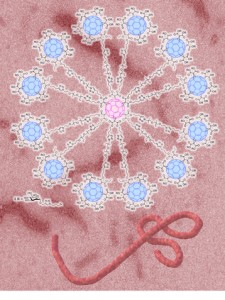A recent study shows that a large fullerene system can interrupt the infection of an artificial Ebola virus. An infection with Ebola starts when the virus gains access to the cellular DC-SIGN receptor and begins to infect the immune system’s dendritic cells. Thanks to the new, larger molecule comprised of fullerenes that are coated with carbohydrates, scientists can block the receptor and interrupt the infection. This has been tested on an artificial virus model.
Researchers attained a remarkable feat of linking 12 different fullerenes. Each of the fullerenes has 10 sugar moieties that link with other central fullerene. This serves to mimic the carbohydrates that are part of Ebola. “Fullerenes are hollow cages exclusively formed by carbon atoms,” Nazario Martín, professor of organic chemistry in the Universidad Complutense de Madrid and the study’s main author, said. “We have employed a cell model previously described in our lab which consists in a cell line of human lymphocytes expressing DC-SIGN receptor, which facilitates the entry of the virus in Dendritic Cells,” study co-author Rafael Delgado, a researcher at the Hospital 12 de Octubre, said.
Researchers first prepared fullerenes that each carried ten mannoses, then grafted these units on to a central, twelve-branched fullerene. This is the first thirteen-fullerene molecule to have been synthesized. Above all, this construction mode represents the most rapid dendritic growth ever achieved, as the giant molecules can be prepared within a minimum number of synthetic steps (six, compared with twenty using traditional methods), which makes it possible to obtain a relatively high global yield of around 20%.The ability of these mega-molecules to inhibit the entry of Ebola virus was then tested in vitro. These molecules are water-soluble and in no way toxic to cells in culture. Their antiviral activity proved to be remarkable, representing a 33% improvement on that of classic antivirals. This efficacy is due to the large number of sugars at the periphery of the molecule, a model molecule with only 12 sugars is approximately 1,000 times less active, and a molecule with a single sugar is 100,000 times less active.
“Fullerenes are hollow cages exclusively formed by carbon atoms”, explains Nazario Martín, Professor of Organic Chemistry in the UCM and main author of the study. In this work, scientists have employed C60 fullerene, which is formed by 60 carbon atoms and has the shape of a truncated icosahedron, which resembles a football ball.These molecules decorated with specific carbohydrates (sugars) present affinity by the receptor used as an entry point to infect the cell and act blocking it, thus inhibiting the infection.Researchers employed an artificial ebola virus by expressing one of its proteins, envelope protein GP1, responsible of its entry in the cells. In a model in vitro, this protein is covering a false virus, which is able of cell infection but not of replication. “We have employed a cell model previously described in our lab which consists in a cell line of human lymphocytes expressing DC-SIGN receptor, which facilitates the entry of the virus in Dendritic Cells”, points out Rafael Delgado, researcher of the Hospital 12 de Octubre, and other of the authors of the study. By blocking this receptor and inhibiting the virus infection, the authors think that the dissemination of the virus would decrease and the immune response increase, but this idea has still to be developed with in vivo studies.
In addition to the Ebola virus, other pathogens (such as the AIDS or dengue viruses) also use the DC-SIGN receptor as their portal of entry into cells. These findings thus open the way to potential applications for these mega-molecules. However, before the molecules constructed according to this principle can perhaps enter the market, they need to go through numerous developmental stages and in vivo tests. According to scientists, the results highlight the potential of these giant molecules as antiviral agents. “This work open the door to the design and preparation of new systems to inhibit the pathogens infection in cases where the current therapies are not effective or are inexistent, as occurs with the ebola virus”, clarifies Martín. After these experiments on the cellular level, researchers will study the behavior of these systems in animal models, starting with mice. “We will study, on the one hand, the pharmacokinetics and, on the other, the antiviral activity in vivo” explains Javier Rojo, researcher of the Instituto de Investigaciones Químicas del CSIC and other of the authors of the study. Once the most effective compound has been identified, studies using the true ebola virus could be carried out.
For more information please visit: www.ucm.es


Comments are closed.